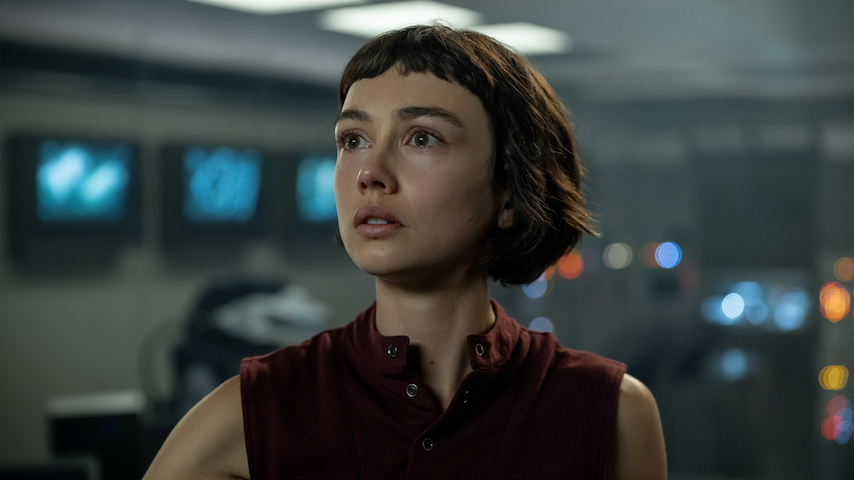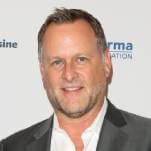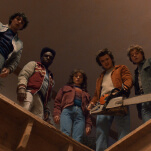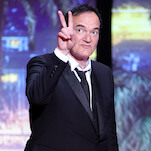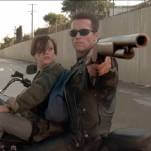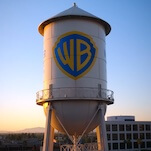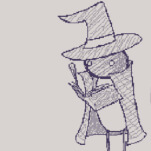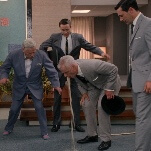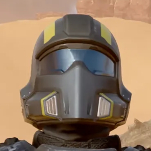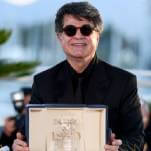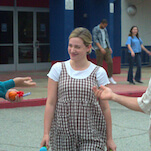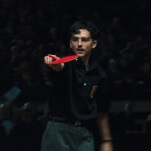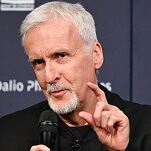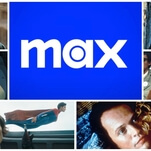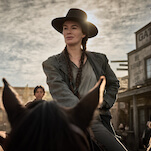The Alien series is a game of exquisite corpse. Even before James Cameron assumed the reins from Ridley Scott, director John Carpenter mined Dan O’Bannon’s early ideas of an extraterrestrial slasher movie for his sci-fi comedy student film, Dark Star. But it wasn’t until Ridley Scott married O’Bannon’s script to Sigourney Weaver’s Ripley and H.R. Giger’s BDSM-inspired design language that the series took shape. Since 1979, there has been an Alien war film, an Alien prison film, an aggressively French interpretation, and a couple of Vs. Predator movies that aim for and occasionally hit the dumb-fun bullseye. When Scott returned for Prometheus and Alien: Covenant, he expanded his ideas from 1979 with metatextual musings prequels in the macro for philosophical splatter fests about humanity’s relationship to intelligent design and designed intelligence. Through Michael Fassbender’s portrayal of David, Scott theorized that, after 33 years away, the most alien aspect of these movies might be the synthetic robots.
FX’s Alien: Earth, the franchise’s first TV series, picks up where Scott left off. Set in 2120, roughly 15 years after Covenant and two years before 1979’s Alien, the first episode of Earth appears as interested in synthetics as Xenomorphs. “If we’re making Blade Runner,” creator Noah Hawley said before the premiere, “we’re making the wrong Ridley Scott movie.” At least with the first episode, “Neverland,” you can see why he was concerned.
Hawley is a remix artist best known for FX’s Legion, a trippy, almost forgotten X-Men spin-off that remains one of Marvel’s better television experiments, and Fargo. On the latter, he used the Coen brothers’ 1996 Oscar winner as a jumping-off point to explore the directors’ career-long interests, mashing together all their works so that Miller’s Crossing‘s gang wars can interact with The Man Who Wasn’t There‘s UFO encounters in a unified thesis statement on filmmakers Hawley reveres. With “Neverland,” Hawley, again, looks beyond the title and splits the difference between Scott’s beloved sci-fi masterpieces, Alien and Blade Runner, offering a ruthlessly efficient remake of the former and the childlike, electric dreams of the latter.
Written and directed by Hawley, who wrote all eight episodes of the series and directed the first half of tonight’s two-part premiere, the show resets and expands the Alien mythos. He builds out the corporate hellscape of Earth 95 years from now, showing us, for the first time, the companies that sent the Nostromo to collect the facehugger. But instead of the Nostromo, we meet what could be its sibling ship, the Maginot. Our time with the Maginot is for exposition, primarily. After awakening from a dreamy, cross-fade heavy hypersleep, we meet an assortment of Alien archetypes sitting around the breakfast table, reciting conversations we’ve heard before. Complaints about the food and questions about the mission are mixed in with helpful exposition about which corporation owns which continents and planets and the differences between synthetics and cyborgs.
Hawley takes great pains in re-establishing that sterile Nostromo atmosphere. Composer Jeff Russo hits Jerry Goldsmith’s familiar soundtrack. Production designer Andy Nicholson lovingly recreates the spacecraft with practical sets that look direct from 1979 and, similar to Andor, meld into the background and don’t call attention to themselves. As they did in 1979, the slow cross-fades between moments elicit the feeling of waking up from a heavy sleep, recentering us in the world and settling the audience back into Scott’s atmosphere. Yet the smartest thing about it is that we don’t spend time here. Hawley does an Alien remake in the edit, showing us flashes of the inevitable containment breach of the mission’s precious cargo and subsequent bloodbath.
There’s only one character on the Maginot worth meeting, and it’s Morrow, the ship’s cyborg security officer. Hiding in the MU/TH/UR room and setting a collision course for Earth, Morrow leaves his would-be Ripley to die by the Xenomorph’s little mouth. (To the episode’s credit, it doesn’t delay an appearance from the big kitty.) But while the rest makes sense to seasoned Alien watchers, why is Morrow so intent on crashing the ship in Prodigy City? The question hangs over the episode.
The other half of the episode lets us know what’s happening on Prodigy through the eyes of a “hybrid” named Wendy (Sydney Chandler). Here’s why Hawley worried about making the wrong Ridley Scott movie. Led by a young tech virtuoso named—I shit you not—Boy Kavalier (Samuel Belkin), Prodigy runs the southern half of Africa, Australia, and South East Asia. Prodigy City, or New Siam, is where Boy does his work, which concerns taking sick children, like Wendy, and transferring their consciousness into synthetic adult bodies. The episode’s opening text tells us that whoever cracks how hybrid humans will win the robotic arm race. Boy has finally done that by dumping the contents of a sick child’s brain into the body of a 30-year-old woman. But transferring consciousness leaves the hybrids feeling empty because Wendy doesn’t understand her adult body. Wendy can leap from great heights and attach a paper cutter to her magnetic spine, but she misses eating and watching Ice Age with her brother, Hermit (Alex Lawther). Her hybrid body doesn’t come with an owner’s manual, so she’s guided by the cold synthetic Kirsh (Timothy Olyphant, who relishes playing a robot) and Dame Sylvia (Essie Davis), who’s presumably a human or, at least, a synthetic with more advanced bedside-manner programming.
Wendy is the first of many sick kids turned hybrid humans that Kirsh and Dame will be assisting. Appropriately (or annoyingly, if you’re allergic to J.M. Barrie), Wendy (goddamn it) calls her “Lost Boys.” Just in case we didn’t get it from Boy Kavalier playing Disney’s Peter Pan (now that’s what I call corporate synergy) during the consciousness transfer, all the Lost Boys are named after characters from the film (Tootles, Slightly, Nibs). The allusion hammers home the theme of the episode about staying forever young like Peter Pan. But once the Maginot crashes into Prodigy City, the two plots converge, as Wendy and her Lost Boys spring into action, leaving Neverland for the exact opposite: an Alien movie.
Picking up immediately after Black Sabbath’s “The Mob Rules” ends, the second episode, “Mr. October,” gives viewers what they expected from a show called Alien: Earth. Set in the building that is now the Maginot‘s crash site, Hermit and a pair of marines conduct a search and rescue mission as Wendy and her Lost Boys do the same for Hermit. These scenes with the Lost Boys can be pretty trying, given that these bots have the consciousness of children. Many of the performances rely on playacting as kids, which can get tiresome (especially when they aren’t that funny). However, it gives Slightly (Adarsh Gouav) reason to immediately blurt out Wendy’s plan to find her brother in front of Kirsh. Thankfully, being a thoroughbred Prodigy synthetic, Kirsh is more interested in the flora (or is fauna?) attached to the ceiling.
Most importantly, the apartment building gives the Xenomorph room to play. As is the case in reality, whether it be a global pandemic or a spaceship containing numerous alien lifeforms crashing into their condo, rich people are immune to external tragedy. That’s true regardless of the circumstances but especially when they’re dressed as extras from Amadeus. The 18th-century costume party is as good a buffet that’s ever existed for the alien hunter. That Hermit tries to get the idiot to evacuate makes his death even more delicious. You want there to be some chum in the waters for the monster to chew on, and it’s a credit to the leniency FX gives toward violence because the show goes hard on the brutality in these scenes, with the Xenomorph cutting through the members of Prodigy City’s one percent like paper and leaving nothing but entrails behind. Once inside, Hermit comes face-to-little-face with the monster in a slow-motion sequence recalling the alien’s Vs. Predator days, which arrives in time for Morrow to bag and tag the beast in a futuristic and seemingly biological net.
What’s missing in all this action is scares. The first time we meet the Xenomorph, it’s for the audience’s edification, popping out from behind a collapsed wall as if to say, “Don’t forget about me!” This happens throughout, with the conspicuous Xenomorph appearing in the frame and announcing its presence. “Mr. October” director Dana Gonzales isn’t the first person to struggle to make the monster scary after 1979. Still, it is a persistent issue within the episode, which lacks tension despite the preponderance of monsters stalking the building.
Another issue is Boy Kavalier, who is perhaps the most purposefully annoying character in the series since Paul Resier’s Burke, the company stooge that leads Ripley’s doomed team in James Cameron’s sequel. There needs to be someone in these movies that the audience can’t wait to see maimed, and few fit the bill better than young Mr. Kavalier. Take his talk with Dame Sylvia, in which he pines for a person or a synthetic who challenges him. Hawley has more hope in today’s tech wizards than I do because at least Kavalier is trying to make a product that fulfills his function. His modern-day equivalents are more interested in revolutionizing SPAM, deepfake revenge porn, and metaverses for their various Nazi and bot-plagued social networks. But still, it’s not lost on Dame Sylvia how fucking rude it is for Kavalier to tell her to her face that she’s not on his level and that maybe, with the proper training, a synthetic with the consciousness of a child can do it. This dude is in Neverland.
The first two episodes of Alien: Earth throw a lot at the viewer. Some of it is even pretty interesting. It’s striving for a unique tone, but in this premiere outing, it hews too close to the magical orphans of Alien Romulus. This whole thing could use a touch more Harry Dean Stanton energy. However, it’s also trying to be the Andor of the Alien world, recreating the design language of the original while elevating the political and social framework that’s always been present. There’s a lot to dig into between Prodigy and Weyland-Yutani—to say nothing of the three other corporations we have yet to meet—and the ship crash gives Hawley good reason to explore the relationships of our current overlords. These companies have everything, and one of the things founders like Kavalier want is whatever they don’t have, primarily the eyeball squid monsters Yutani is desperate to copyright. One might assume that he’s going to regret that, but if Weyland-Yutani’s centuries-long search for the Xenomorph teaches us anything, he won’t.
Stray observations
- • Hi! I’m Matt Schimkowitz, A.V. Club Staff Writer. You may remember me from newswires or my coverage of Barry and The Lord Of The Rings: The Rings Of Power. I’ll be recapping Alien: Earth over the next few weeks. A little background: I’m a big fan of the Alien movies, including Scott’s underrated last two, Covenant and Prometheus. I’ve also enjoyed Hawley’s work in the past, particularly Fargo‘s second season and Legion‘s first.
- • The track may be killer, but the use of the Dio-era Black Sabbath track “The Mob Rules” feels oddly disrespectful considering Ozzy’s recent passing.
- • While I’m on that topic, I can’t stand the pop-culture references on this show. The idea of kids 100 years from now still watching Ice Age is a bit preposterous, but watching 100-year-old baseball games? They’re going to have to work a lot harder to sell me on Wendy and Hermit’s obsession with Gen X and millennial pop culture. At least Guardians Of The Galaxy had a reason for its soundtrack. There’s 1,000=percent more Ice Age on this show than I was ready for, and the choice feels like something they could pull from the Disney vault. If we wanted realism, these kids would be watching Universal’s Minions or Dreamworks’ Shrek.
- • I’m consistent in this because I also hate that Alien: Covenant‘s entire plot hinges on Danny McBride knowing John Denver’s “Take Me Home, Country Roads.” I would rather see Scott or Hawley’s vision for the future of music and movies than assume characters will be captivated by music about West Virginia, a state that might not even exist in this reality, or crudely animated CGI movies.
- • I get that the show needs to hammer home Boy Kavalier taking a bite of the apple from the Tree of Knowledge, but can’t he afford a better apple than Red Delicious? A damning vision of the future: There are no more Gala apples. Horrifying.
- • Of all the Lost Boys, I’m keeping a close eye on Smee (Jonathan Ajayi), who is the only one named after a pirate.
- • I get that they’re taking names from Peter Pan, but is Hermit extrapolated from Newt?
